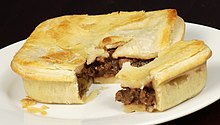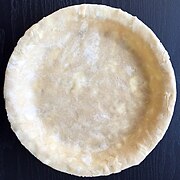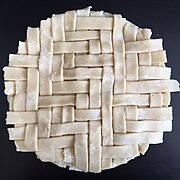
Puff pastry, also known as pâte feuilletée, is a light, flaky pastry, its base dough composed of wheat flour and water. Butter or other solid fat is then layered into the dough. The dough is repeatedly rolled and folded, rested, re-rolled and folded, encasing solid butter between each resulting layer.

Cake is a flour confection made from flour, sugar, and other ingredients and is usually baked. In their oldest forms, cakes were modifications of bread, but cakes now cover a wide range of preparations that can be simple or elaborate and which share features with desserts such as pastries, meringues, custards, and pies.

Pastry refers to a variety of doughs, as well as the sweet and savoury baked goods made from them. These goods are often called pastries as a synecdoche, and the dough may be accordingly called pastry dough for clarity. Sweetened pastries are often described as bakers' confectionery. Common pastry dishes include pies, tarts, quiches, croissants, and pasties.

A pie is a baked dish which is usually made of a pastry dough casing that contains a filling of various sweet or savoury ingredients. Sweet pies may be filled with fruit, nuts, fruit preserves, brown sugar, sweetened vegetables, or with thicker fillings based on eggs and dairy. Savoury pies may be filled with meat, eggs and cheese or a mixture of meat and vegetables.

An apple pie is a pie in which the principal filling is apples. Apple pie is often served with whipped cream, ice cream, custard or cheddar cheese. It is generally double-crusted, with pastry both above and below the filling; the upper crust may be solid or latticed. The bottom crust may be baked separately ("blind") to prevent it from getting soggy. Tarte Tatin is baked with the crust on top, but served with it on the bottom.

A croissant is a French pastry in a crescent shape made from a laminated yeast dough similar to puff pastry.

Dough is a malleable, sometimes elastic paste made from grains or from leguminous or chestnut crops. Dough is typically made by mixing flour with a small amount of water or other liquid and sometimes includes yeast or other leavening agents, as well as ingredients such as fats or flavourings.

A mooncake is a Chinese bakery product traditionally eaten during the Mid-Autumn Festival (中秋節). The festival is primarily about the harvest while a legend connects it to moon watching, and mooncakes are regarded as a delicacy. Mooncakes are offered between friends or on family gatherings while celebrating the festival. The Mid-Autumn Festival is widely regarded as one of the four most important Chinese festivals.
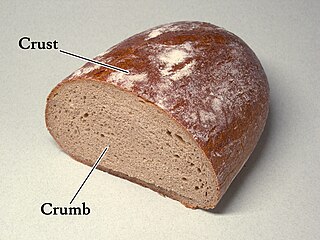
In baking, a crust is the outer, hard skin of bread or the shell of a pie. Generally, it is made up of at least shortening or another fat, water, flour, and salt. It may also include milk, sugar, or other ingredients that contribute to the taste or texture. An egg or milk wash can be used to decorate the outside, as well as coarse sugar. A crust contributes to a pastry.
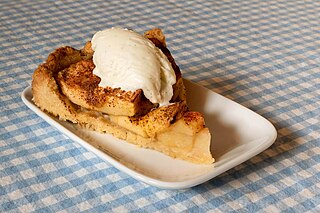
Apple cakes are cakes in which apples feature as a main flavour and ingredient. Such cakes incorporate apples in a variety of forms, including diced, pureed, or stewed, and can include common additions like raisins, nuts, and 'sweet' spices such as cinnamon or nutmeg. They are a common and popular dessert worldwide, thanks to millennia of apple cultivation in Asia and Europe, and their widespread introduction and propagation throughout the Americas during the Columbian Exchange and colonisation. As a result, apple desserts, including cakes, have a huge number of variations.

Kuchen, the German word for cake, is used in other languages as the name for several different types of savory or sweet desserts, pastries, and gateaux. Most Kuchen have eggs, flour and sugar as common ingredients while also, but not always, including some fat. In the Germanosphere it is a common tradition to invite friends over to one's house or to a cafe between noon and evening to drink coffee and eat Kuchen.

A pot pie or potpie is a type of savory pie, usually a meat pie, covered by a pie crust consisting of flaky pastry. Pot pies may be made with a variety of fillings including poultry, beef, seafood or plant-based meat substitute fillings, and may also differ in the types of crust.
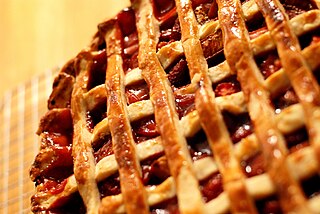
Lattice pastry is a pastry woven in a criss-crossing pattern of strips in the preparation of various foods. Latticed pastry is used as a type of lid on many various tarts and pies. The openings between the lattice allows fruit juices in pie fillings to evaporate during the cooking process, which can caramelize the filling.

A meat pie is a pie with a filling of meat and often other savory ingredients. They are found in cuisines worldwide.
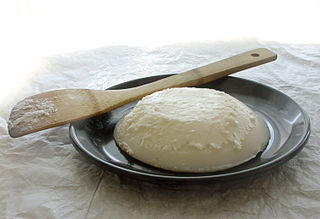
Lard is a semi-solid white fat product obtained by rendering the fatty tissue of a pig. It is distinguished from tallow, a similar product derived from fat of cattle or sheep.

Gâteau Basque is a traditional dessert from the North of Pays Basque, a region of France, typically filled with black cherry jam or pastry cream. Gâteau Basque with cream is more typical in the South of Pays Basque, a region of Spain.

Laminated dough is a culinary preparation consisting of many thin layers of dough separated by butter or other solid fat, produced by repeated folding and rolling. Such doughs may contain more than eighty layers. During baking, water in the butter vaporizes and expands, causing the dough to puff up and separate, while the lipids in the butter essentially fry the dough, resulting in a light, flaky product.

Chinese flaky pastry is a form of unleavened flaky pastry used in traditional Chinese pastries that are invariably called subing. There are two primary forms, Huaiyang-style (淮揚酥皮) and Cantonese-style pastry (廣式酥皮). Huaiyang-style pastry is used to make delicacies such as Shanghainese 'crab shell' pastries (蟹殼黃) while Cantonese-style pastry is used to make pastries like sweetheart cakes.
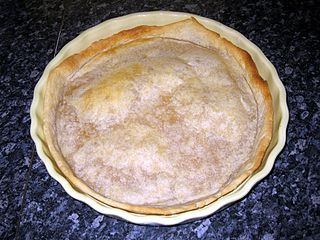
Pâte brisée is a type of short dough. It is an unsweetened pastry used for raised pies with meat fillings and savory custard filled quiches like Quiche Lorraine.
